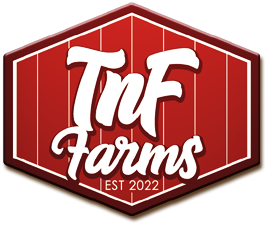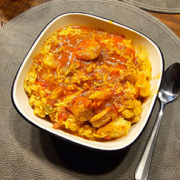TnF Farms Jambalaya
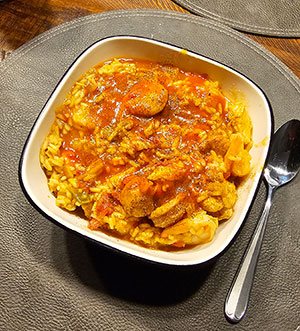
Bring on the heat with my bowl of jambalaya!
We enjoy trying new foods at TnF Farms. I have had jambalaya a number of times since moving to the south. I think it’s pretty good. I’ve been wanting to try my hand at making some of my own. Porterhouse Meat Market has been featuring alligator crab boil bratwurst. In my experiments to really get this jambalaya dish to pop, I’ve had to visit Porterhouse a few times as my previous attempts have not measured up. Fawzi, the owner of Porterhouse has been kind enough to set a few packages of the alligator crab boil bratwurst aside for me as it seems to sell out fast. Yes, you can get some amazing jambalaya out to eat. But in our theme of beating the restaurants with an easy, great meal for 2 for under $30, let’s get started.
So what exactly is jambalaya?
Jambalaya is a popular and flavorful comfort dish rooted in Creole and Cajun cuisine, particularly associated with the state of Louisiana in the United States. It’s known for its rich and spicy flavors. Often considered a one-pot meal because it combines a variety of ingredients in a single pot.
Jambalaya basics
- Protein: Jambalaya can feature various proteins such as chicken, shrimp, sausage (like andouille or smoked sausage), or a combination of these.
- The Trinity of Vegetables: This consists of onions, bell peppers, and celery, which form the flavor base for many Creole and Cajun dishes.
- Rice: Long-grain white rice is traditionally used, and it absorbs the flavorful broth and spices.
- Seasonings: Jambalaya is seasoned with a mix of spices and herbs like cayenne pepper, paprika, thyme, and bay leaves. It’s known for its bold and spicy flavor.
- Broth: A flavorful broth or stock (often chicken or seafood) is used to cook the rice and create a delicious, savory base.
There are two primary variations of jambalaya. Creole and Cajun. Creole jambalaya tends to be tomato-based, resulting in a reddish appearance, while Cajun jambalaya is brown in color and doesn’t typically include tomatoes.
Let’s start cooking
You can get all these ingredients at Porterhouse. I had some of my ingredients in the pantry and we had a Barred Rock rooster that volunteered to participate in dinner. I’m going Creole style as I really like tomatoes. This isn’t going to be a giant batch and I’m going to take a few short cuts. After working all day, we want this plated up in less than an hour. Hopefully the good people of Louisiana will forgive some of my non-traditional short cuts.
I take a 12” skillet and add a large dollop of pig butter (bacon grease) on medium heat. From here I slice up my Porterhouse Meat Market alligator crab boil brats, a cantankerous Barred Rock rooster from TnF Farms, yellow onion, green pepper and some celery.
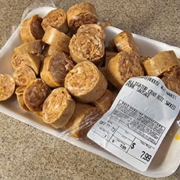
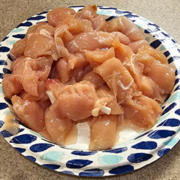
Then I work some seasonings in. My wife prefers no spice. So I’m going to keep the seasoning pretty tame.
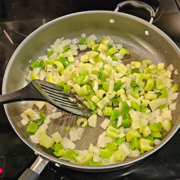
Once I have the meat cooked and the veggies have softened, I add 2 cans of spicy Rotel.
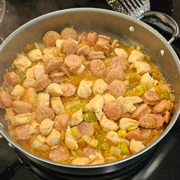
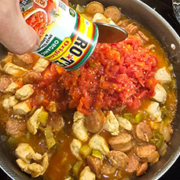
I then add a package of flavored yellow rice and chicken bone broth. I’m going to crank the range’s heat all the way up to cook the rice. I keep moving everything around so I don’t scorch the food making contact with the skillet.
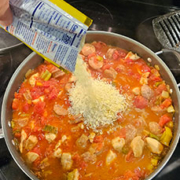
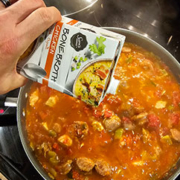
The rice as softened with a lot of the flavors cooked in. A quick taste and I think I’m going to add a little ground garlic. I have some pre-cooked, peeled shrimp from the fridge. They will over cook pretty quick. I add them at the end just to bring them to temperature.
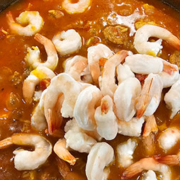
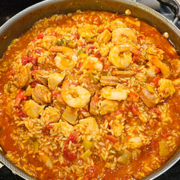
Let’s Eat
We’re plated up. Faith taste tested and I still made it too spicy. I prefer to bring on the heat. I’m going with a generous sprinkling of Tony Chachere’s creole seasoning and some hot sauce.
